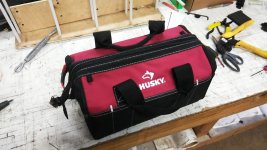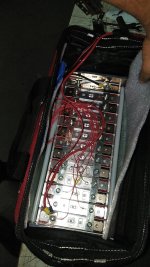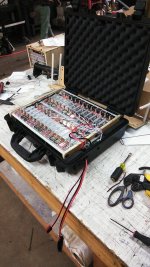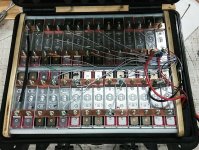You are using an out of date browser. It may not display this or other websites correctly.
You should upgrade or use an alternative browser.
You should upgrade or use an alternative browser.
VW e-up Li-ion cels
- Thread starter Joachim
- Start date
okashira
10 kW
The pack it came from is just one parallel, and they only run 230A peak.Joachim said:ok not the c-rate of a singel cel bud if you put more cells parallel you have more Ah so you can pul out more C out of the battery pack....just like you
write down here....my question: pulling 750Amps out of a singel cell?are more cells in parallel?
So you pul 750A from a singel celi dont try this@home :lol:
I have not actually pulled 750A, I could, however it is not necessary, one can make measurements at lower current and extrapolate the result.
Like I said, I tested about 0.0011 Ohm DCIR, so at 750A the voltage drop would be about 0.83V which is perfectly acceptable for a 3.7V cell for 5-10 seconds.
Hillhater
100 TW
Panasonic also make a 5 Ahr (smaller) version of these prismatics as used in the Ford CMax Hybrid.
That cell is rated at 47C discharge for 10 secs.
That cell is rated at 47C discharge for 10 secs.
Pajda
10 kW
It must be a pleasure for automotive makers to build an electric cars with such cells if you are don't worry about range :?
Great info anyway. Does anyone know the original Panasonic marking of those cells? Any documentation? Or does anybody seen the "new VW" 36Ah cells, which are supposed to be in the same size?
Great info anyway. Does anyone know the original Panasonic marking of those cells? Any documentation? Or does anybody seen the "new VW" 36Ah cells, which are supposed to be in the same size?
Pajda
10 kW
Joachim can you please measure for me also a dimensions of a whole VW module, thx.
999zip999
100 TW
750a I need proof.
no i dont havePajda said:Joachim can you please measure for me also a dimensions of a whole VW module, thx.
liveforphysics
100 TW
okashira said:The pack it came from is just one parallel, and they only run 230A peak.Joachim said:ok not the c-rate of a singel cel bud if you put more cells parallel you have more Ah so you can pul out more C out of the battery pack....just like you
write down here....my question: pulling 750Amps out of a singel cell?are more cells in parallel?
So you pul 750A from a singel celi dont try this@home :lol:
I have not actually pulled 750A, I could, however it is not necessary, one can make measurements at lower current and extrapolate the result.
Like I said, I tested about 0.0011 Ohm DCIR, so at 750A the voltage drop would be about 0.83V which is perfectly acceptable for a 3.7V cell for 5-10 seconds.
Every cell has some point of ionic pathway saturation, at which point it no longer behaves with a linear relationship to impedance. Finding out where a cell saturates can be tricky, many high C rate RC pouches will blow there own tabs before saturating the cell. It very well may be this cell does 750A, it also may saturate before that or any number of other high current failure modes before reaching 750A.
Hillhater
100 TW
The Ford CMax Hybrid uses the 5Ahr version of this cell the cells, partly because they have thinner electrodes to give better charge/discharge rates.
The 25 Ahr cell is listed as a "High Energy" variant.
The 25 Ahr cell is listed as a "High Energy" variant.
okashira
10 kW
liveforphysics said:okashira said:The pack it came from is just one parallel, and they only run 230A peak.Joachim said:ok not the c-rate of a singel cel bud if you put more cells parallel you have more Ah so you can pul out more C out of the battery pack....just like you
write down here....my question: pulling 750Amps out of a singel cell?are more cells in parallel?
So you pul 750A from a singel celi dont try this@home :lol:
I have not actually pulled 750A, I could, however it is not necessary, one can make measurements at lower current and extrapolate the result.
Like I said, I tested about 0.0011 Ohm DCIR, so at 750A the voltage drop would be about 0.83V which is perfectly acceptable for a 3.7V cell for 5-10 seconds.
Every cell has some point of ionic pathway saturation, at which point it no longer behaves with a linear relationship to impedance. Finding out where a cell saturates can be tricky, many high C rate RC pouches will blow there own tabs before saturating the cell. It very well may be this cell does 750A, it also may saturate before that or any number of other high current failure modes before reaching 750A.
Will find out soon.
At 230A they show no sign of complaining - dropping about 0.25V from rest.
Isn't the ionic pathway (the electrolyte conductivity?) measured by a simple ACIR test? I'd be more concerned with the anode and cathode density below the surface for a high rate DC test relative to an ACIR test?
InterestedinEVs
1 kW
- Joined
- Sep 21, 2010
- Messages
- 309
Any new news on these guys? I've been eyeing them!
minde28383
10 kW
- Joined
- Apr 2, 2010
- Messages
- 700
They are NMC.
Lithium Nickel Manganese Cobalt Oxide (NMC).
Good heavy cell, ~735g per cell.
Cells can't 750A when connected in 1P.
From 1P you can expect up to 400A / 450A for few seconds. You can't pull 400A for a minute.
If you need 750A peaks for few seconds then 2P will do it, but we are talking about short peaks.
They will get low cycles if peaked frequently to their limit as all current cells.
Lithium Nickel Manganese Cobalt Oxide (NMC).
Good heavy cell, ~735g per cell.
Cells can't 750A when connected in 1P.
From 1P you can expect up to 400A / 450A for few seconds. You can't pull 400A for a minute.
If you need 750A peaks for few seconds then 2P will do it, but we are talking about short peaks.
They will get low cycles if peaked frequently to their limit as all current cells.
Chalo
100 TW
I built a 13S pack with those (which I think came out of a Ford?) and it's the most satisfactory battery I've ever used. It's 26 pounds including enclosure, but worth it. My previous 18650 pack seems like a toy by comparison. I'm only pulling up to 35A, so they'll probably do that job longer than they would in their original role.
liveforphysics
100 TW
Chalo said:I built a 13S pack with those (which I think came out of a Ford?) and it's the most satisfactory battery I've ever used. It's 26 pounds including enclosure, but worth it. My previous 18650 pack seems like a toy by comparison. I'm only pulling up to 35A, so they'll probably do that job longer than they would in their original role.
Share pics buddy so others can see. I love to see the EV car waste stream able to power ebikes.
Chalo
100 TW
liveforphysics said:Chalo said:I built a 13S pack with those (which I think came out of a Ford?) and it's the most satisfactory battery I've ever used. It's 26 pounds including enclosure, but worth it. My previous 18650 pack seems like a toy by comparison. I'm only pulling up to 35A, so they'll probably do that job longer than they would in their original role.
Share pics buddy so others can see. I love to see the EV car waste stream able to power ebikes.
It took me a little while to remember to unpack my battery and take pictures. But here are a few:
My 13S 1P pack in its bag. It has 3mm plywood underneath and closed cell polyethylene foam on all sides.

It's only a 35A BMS at the moment, but that works for what I do with it. Anderson PP45 plugs for discharge and XLR mic plug for charge.
The white rods on either side are polyethylene tubing sleeved over 1/4" steel threaded rod for cell compression. I used 1/4" aluminum end plates, which were only just thick enough to do the job.

Here's a 14S 2P (2.6 kWh) pedicab battery I just finished at work. It's set up with a 60A Bluetooth programmable BMS. I made my own bus bars for this one. The case is a Pelican clone that weighs about 7 pounds; this battery weighs close to 60 pounds all up. Anderson SB50 for discharge and PP45 for charge.
In the background you can see a plywood-clad battery I built using the original 21S module, reconfigured as 10S 2P. That one can power the pedicabs we have configured to have flat screen video tailgates running on 36V, with or without motor assist.


I don't know why it's appending one of the above images at the end, but I can't figure out how to make it not do that.
Attachments
liveforphysics
100 TW
Thanks for sharing my friend. 
If you mean between the cell casings, they're probably for this scenario:
If you have a metal-cased cell, and something happens inside the cell, it could short one of the poles to the case. As long as the case is electrically insulated from the rest of the pack, that doesn't affect anything. But if the cases are connected together, then the *next* cell that this happens to will then create a direct short across all the cells between those two cells, which is generally very bad.
Or if the cell casings are interconnected to each other and the frame (of case, vehicle, etc), and then any wiring coming out of the pack also shorts to the case, frame, etc., then again a direct short is created across those....
As long as none of those happens, there's no problem. The likelihood is pretty small (though the consequences could be bad), rather like that of recharging cells that have dropped below their minimum.
Without dividers between the cells, they'll fit in a smaller space, which can be important on a bike.
If you have a metal-cased cell, and something happens inside the cell, it could short one of the poles to the case. As long as the case is electrically insulated from the rest of the pack, that doesn't affect anything. But if the cases are connected together, then the *next* cell that this happens to will then create a direct short across all the cells between those two cells, which is generally very bad.
Or if the cell casings are interconnected to each other and the frame (of case, vehicle, etc), and then any wiring coming out of the pack also shorts to the case, frame, etc., then again a direct short is created across those....
As long as none of those happens, there's no problem. The likelihood is pretty small (though the consequences could be bad), rather like that of recharging cells that have dropped below their minimum.
Without dividers between the cells, they'll fit in a smaller space, which can be important on a bike.
pwd
10 kW
Do you figure these are the same cells ? https://www.ebay.ca/itm/294029958804
Wondering how well they can handle 140A peak for around 10 seconds?
Wondering how well they can handle 140A peak for around 10 seconds?
Chalo
100 TW
pwd said:Do you figure these are the same cells ? https://www.ebay.ca/itm/294029958804
Wondering how well they can handle 140A peak for around 10 seconds?
Those cells are rated for 300A continuous, but they're probably old enough by this point that they will sag precipitously if you do that.
I only ask 35A from mine, so I can't tell you what they'll do at four times the current.
Similar threads
- Replies
- 11
- Views
- 634
- Replies
- 30
- Views
- 1,109
- Replies
- 32
- Views
- 2,078
- Replies
- 4
- Views
- 634


